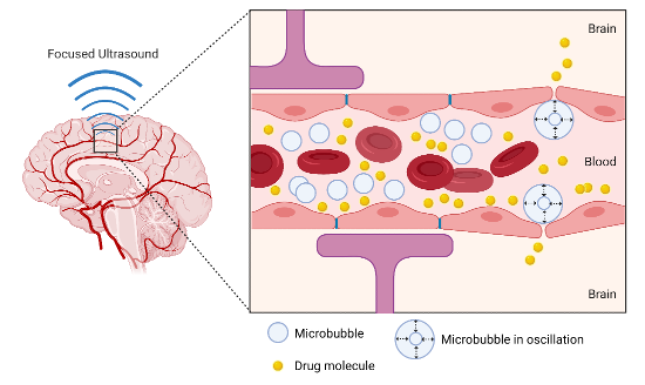Recently, the research team led by Assistant Professor Cheng Bingbing from the School of Biomedical Engineering at ShanghaiTech University published a research paper titled “Multiple Instance Learning-Based Prediction of Blood-brain Barrier Opening Outcomes Induced by Focused Ultrasound” in IEEE Transactions on Biomedical Engineering. The study developed a deep learning method to achieve rapid and accurate evaluation of the focused ultrasound (FUS)-induced blood-brain barrier (BBB) opening outcomes, which is pivotal for facilitating the clinical translation of the FUS BBB opening technology.
The BBB is a semipermeable membrane that protects the brain while severely hindering drug delivery to the brain. Micro/nanobubbles-assisted FUS BBB opening is a promising brain drug delivery technology, which is noninvasive, targeted, and reversible (Figure 1). However, existing methods for assessing the efficacy of FUS BBB opening are time-consuming, inconvenient, or cost-effective. For example, the current clinical gold standard, contrast-enhanced T1-weighted MRI, requires expensive MRI equipment, lengthy scanning time, and the injection of gadolinium, which is difficult to eliminate from the body. Additionally, it is not suitable for patients with metal implants such as pacemakers, or those suffering from claustrophobia.

Figure 1. Schematic of microbubble-assisted FUS BBB opening
To address this challenge, Prof. Cheng’s group proposed a deep learning model called Simple Transformer-based model for BBB Opening Prediction (SimTBOP) (Figure 2). This innovative method integrates acoustic feedback signals during the FUS-mediated BBB opening and utilizes multiple instance learning (MIL) to enable rapid and accurate assessment of BBB opening outcomes, achieving accuracy rates of up to 96.7%.

Figure 2. Diagram of SimTBOP
Master student Dai Haixin is the first author of the paper and Prof. Cheng is the corresponding author. ShanghaiTech University is the primary affiliation. Associate Professor Wang Qian and PhD student Li Wenjing from Cheng’s group contributed to the study.
*This article is provided by Prof. Cheng Bingbing

